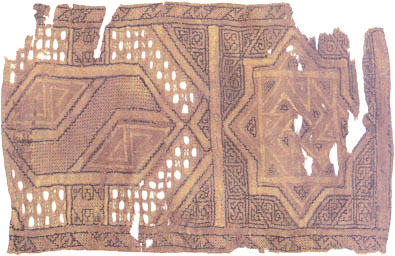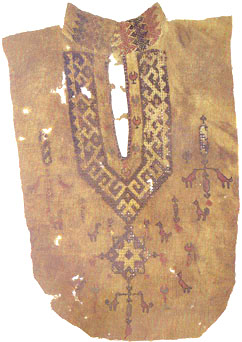Mamluk TextilesHere is a brief history of the Mamluks:
A Brief History - 1250-1517The Mamluk period - from 1250 to 1517 - followed the Ayyubid dynasty. Mamluk comes from a word meaning "owned". The mamluk classes were boys taken from their non-Egyptian parents, at first from among Turkish tribes of Central Asia, later from among peoples of Western Asia, and trained to be expert soldiers and horsemen, to become bodyguards, and perhaps eventually to serve the sultans. As they were freed and given positions as administrators, they were given their own mamluks. Because the state was their only parent, it was assumed that they would be loyal and faithful. These freed mamluks, known as amirs, rapidly rose within the bureaucracy to positions of great power. There were actually two Mamluk periods - the Bahri (1250-1390) and the Burji (1382-1517). The Mamluk Sultanate controled more than Egypt: its territory spread east through the Levant to Syria, west to include parts of Libya, and south to include parts of the Sudan - its borders extended from southeastern Anatolia to the Hijaz in the Arabian peninsula. Mamluk rule didn't end until 1517, when Egypt was conquered by the Ottoman Turks. Among their achievements was expelling of the Mongols and driving the last of the Crusaders from the Levant. During the Mamluk period trade and agriculture flourished and Cairo, the Mamluk capital, became one of the wealthiest cities in the world and a great cultural and intellectual center. The institution of the mamluks allowed an individual to rise potentially from slave to supreme ruler. During the Mamluk period the sultan had to be elected or confirmed by a council of amirs, freed mamluks. The mamluk military elite were trained to be superb warriors and masters of the art of self-preservation. They kept their disputes among themselves, maintained the bureaucracy running smoothly no matter what was going on elsewhere in the state, and did not allow the interference of native Egyptians or foreigners, thus maintaining their authority and solidarity. The head of the state was the sultan. of mamluk origin. His advisors and administrators were the amirs, also mamluk in origin. The sultan had his own personal mamluks, as bodyguards and officers in the palace; some of them were eventually freed to become amirs. Amirs had their own mamluks who could be freed or passed on to imperial service. The ruling elite were all of foreign origin, not native Egyptian - either Kipchak Turk or Circassian by birth or descent. They were all Muslims but kept their names in their own language. The bulk of the military came from among the ruling elite, being mamluks of the sultan, amirs, and mamluks of the amirs. There were some "native" troops - Egyptian, Bedouin, and Levantine (Palestinian and Syrian) corps - but most of the military were mamluks or former mamluks. And ranking military officers were of course all from mamluk class. The governors of the various states within the Mamluk Empire were also chosen from among the amirs. Mamluks were purchased by a special officer. They were trained in special schools in Cairo as children, then placed as pages in various corps. When the youths had gotten the necessary training, they were placed in the service of amirs. From these positions they could be sent to the palace to serve the sultan. If they served sufficiently well, they could be freed to become amirs and owners and trainers of mamluks themselves. The second most important class in the Mamluk Empire was "the men of the pen". These were native free-born Muslims, and a few select local Christians and Jews. They held civil appointments and served as judges, teachers, administrators, clerks, etc. These were the highest positions a non-mamluk could hold during the Mamluk Empire. The Bahri (Turkish) Period - 1250-1390The mamluks stationed in Cairo under the last strong Ayyubid caliph were known as al-Bahriyya al-Salihiyya: "bahri" means "sea", near which the Cairene mamluks were stationed, and from across which they had come; "salih" was the name of their owner, Sultan al-Salih Najn al-Din Ayyub (ruled 1240-1249). But in 1250, with the collapse of the Ayyubid dynasty, leaders arose among the mamluk class who led the mamluks to take control of the government. Chief among them were Baybars and Qalawun, both Kipchak Turks by birth, who called their state Dawlat al-Turk, The Turkish State. The first Mamluk sultan was Baybars, who was considered chivalrous, energetic, and enlightened. He established good relations with the Byzantine Empire and the Sicilian Kingdom. He formed an alliance with the Golden Horde, the Muslim Kipchak Mongols, sworn enemies of the still pagan Ilkhanid Mongols in Iran. And Baybars developed a friendly rapport with the Seljuk Turks of Anatolia, who were strategically placed between the Mongols and the Christian kingdom of Cilicia. Besides deposing the last of the Ayyubids in Syria, he also destroyed the feared Assassin sect. And finally he allowed the last of the Abbasid dynasty to reestablish the Abbasid caliphate in Cairo after the Mongols destroyed Baghdad in 1258. Baybars was poisoned and died in 1277. Baybars was succeeded briefly by two sons, and then in 1280 by Qalawan, who became the next great Mamluk sultan. Qalawan had been a trusted friend of Baybars: his daughter married one of Baybars' sons and he had been regent to Baybars' 7 year old son, who ruled for four months. Under Qalawan, trade with Yemen, India, and China grew. He rebuilt many fortifications along his borders, and built a lavish complex in Cairo, where he supported the arts. On his death at the age of 70 in 1290 there followed a period during which his sons and certain other mamluks variously deposed and killed each other. Eventually one of Qalawan's sons, al-Malik al-Nasir Nasir al-Din Muhammad took control. He had been sultan for almost one year at the age of 8 in 1294 and again for 10 year, beginning at the age of 14 in 1299. This time he ruled from 1310 until 1341, a reign known for its peace and prosperity. His court was frequented by the leaders of numerous Muslim empires, kings of Europe, and even the Pope. Art and architecture were supported by Nasir al-Din Muhammad and the powerful amirs in the court. Because of the expansion of trade, Mamluk arts began incorporating numerous motifs from the Orient. After the death of Nasir al-Din Muhammad, although his sons and their heirs came to the throne, the true rulers of the Sultanate were really their amirs. The arts continued to flourish. However, in the second half of the 14th century there were several natural and man-made disasters that undermined the Bahri Mamluk state - including livestock and agricultural diseases, the Black Death, depredations by Christian kings and the expansion of the armies of Timur from Central Asia. The Burji (Circassian) Period - 1382-1517In 1382 the last of the Bahris was overthrown by Barquq, a Burji mamluk. Barquq was deposed by the mamluks in support of the Bahri sultan. But Barquq escaped from prison in 1390 and again deposed the Bahri ruler. Barquq was a Burji Mamluk, a Circassian, not a Turk, and unlike other mamluks, he actually knew his father. Barquq formed an alliance with the sultan of the Ottoman Turks and the Khan of the Golden Horde against the advancing Timurids. He also gave refuge to the ruler of Iraq, whose capital city Baghdad had been sacked by the Timurids. He died in 1399, before facing the Timurids. His 13-year-old son, who became sultan after him, could not defeat the Ottomans and was forced to sign a humiliating treaty. The Mamluk ecomony suffered in the first half of the 15th century, as tax revenues fell, military expenditure increased, the currency was devalued, and trade revenues were lost. There were famines and food shortages. In fact, the entire Burji period was one of violence and intrigue. At this time mamluks were often taken as adults who were difficult to train and control - they often harassed the population and incited riots. Offices were sold to pay bribes and buy new slaves, and sultans payed their supporters enormously to remain in control. Nonetheless,the empire managed to expand its borders and continue as a center of trade. The longest ruling Burji sultan was Qaitbay, who reigned from 1468-1496. He was a great patron of the arts, second only to Nasir al-Din Muhammad, and he ruled with great compassion, wisdom, and strength. Because he treated deposed rulers and their descendants with respect, he earned the devotion and loyalty of his mamluks. He improved the state economy, expanded trade, and protected local merchants. However, he earned the antagonism of the sultan of the Ottoman Turks, who invaded Cilicia. Although Qaitbay succeeded in halting the Ottoman advance, he could tell that they would be a major threat to the Mamluk Empire. Another plague hit the Empire during the end of his reign. Despite all this, his was the high point of the Burji period. Following his death came another period of constantly changing rulers. The second to last Burji sultan was Qanush al-Ghri who was chosen by the mamluk council in 1510. He replenished the treasury, rebuilt the army, and strengthened fortresses. He was an intellectual who supported the arts and architecture, and was a poet himself. However, the Ottomans were on the move again, defeating the Safavids of Iran in 1514, then the Zulkairs in southeastern Anatolia. Qanush lead his army against the Ottomans in Syria in August, 1516, but his forces were outnumbered, had inferior artillery, and lacked discipline. Qanush was killed in the battle. The last Burji sultan fought against the Ottomans but faced defeat after defeat and in January 1517 the Ottomans were recognized as rulers of the Mamluk Empire of Syria and Egypt. The Ottomans relied on the mamluks to rule the local bureaucracy. In fact, the first Ottoman governor of Egypt was a Burji amir. The art and architecture of the Ottoman period (1517-1848) in the former Mamluk Empire continued to utilize the Mamluk decorative vocabulary and draw from its traditions. There are still important communities of Circassians in the Levant, especially in Israel. Quite a few textiles and garment fragments have survived from the Mamluk period. Here are a few that have caught my eye. Pictured here are thumbnails. Follow the links to more detailed pictures. I have given the size of the larger pictures that are on the linked pages. Some are very large. Either be very patient or have a fast connection. |
| . | Silk Caps |
. | |
| . |  |  |
. |
| . | Scroll down on linked page to see. |
. | |
| . | Embroidered Fragments |
. | |
| . |  |
 |
. |
| . | 14th century linen fragment: indigo and yellow silk thread on linen, with double running stitch, openwork, and drawn thread |
15th century silk fragment: red, teal, yellow and black silk on silk, with double running stitch and drawn thread scroll down on linked page to see. |
. |
Embroidered Tunic Front |
. | |
| . |  |
. |
| . | Linen Tunic Yoke: Obviously cut from the garment it originally decorated, this tunic front is a veritable sampler of embroidery stitches |
. |
| . | Linked to this page: Yoke picture |
. |
Back up to A Brief History of the Mamluk Empire
|
Back to al-Riyad: The Courtyard in Dar Anahita Questions? Comments? Suggestions?
You can write to me here. |